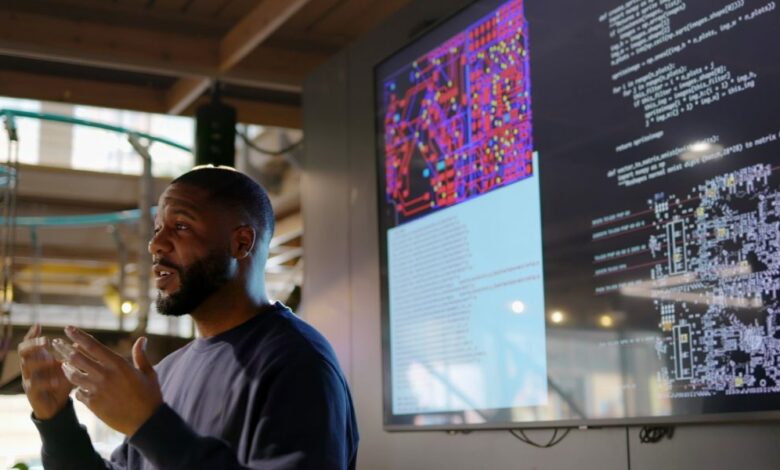Best Python courses: Free and paid options for beginners


Trends for Stack Overflow reveal that Python-related inquiries dominate the platform, accounting for approximately 13% of all questions posted in its Q&A forums.
Insights show that on Stack Overflow, the programming language has consistently outpaced others, like C++, SQL, and R, over the past decade—even surpassing JavaScript in 2018.
ADVERTISEMENT
With Python sitting in that No. 1 spot, it’s no wonder why gaining the necessary skills to master the language is an increasingly popular goal for entry-level data scientists and developers alike.
For those interested in working in artificial intelligence, machine learning, bioinformatics, full-stack web development, and engineering, adding Python to your toolbox can be effective for building a solid career path across many different industries.
What is Python?
Python is a computer programming language that developers use to create websites and software, conduct data analysis, and automate tasks. It’s considered a general-purpose language, which means there are a lot of different applications and situations in which it can be used because it isn’t specialized for any specific problems.
It was developed by Guido van Rossum in 1991, and the name “Python” is a nod to the British comedy group Monty Python.
The good news is that it is easy to learn and read and has a large community of support. That’s according to Wade Fagen-Ulmschneider, a teaching associate professor of computer science at the University of Illinois. He tells Fortune that his Introduction to Data Science Using Python, which started in 2019 with just 16 students, has multiplied over 100 times to 1,659 students at the time of publication.
“A lot of people compare Python to other programming languages like C, C++, or even Java,” Fagen-Ulmschneider says. “But if you look at those languages, you’ll see lots of syntaxes—lots of curly braces, lots of parentheses, lots of square brackets—things that mean something to a programmer but don’t mean anything to somebody with no concept of programming.”
He explains that with Python, you can achieve more with fewer lines of code, symbols, and keywords, leading to faster development. In fact, he thinks you can write your first program in a weekend’s-time.
When it comes to Python courses, Fortune has you covered with programs that can not only help you toy around with the language but also get you on the fast track to becoming a Python developer.
These classes range from free and beginner-friendly to more mid-level, offering certifications or are offered by credible organizations. Note: There is no single best course out there—so consider which best caters to your personal needs, experience level, and career trajectory.
4 free Python courses
These four free courses teach Python at an introductory level. Each varies on program length but offers non-specialized, general coursework.
1. Google’s Python Class
This is the course Google has its employees take to introduce them to Python concepts. This free class contains a tutorial on how to set your computer up for coding and teachings on strings, lists, regular Python expressions, and its common utilities. Materials include several short readings, lecture videos, and exercises.
According to the site, Google typically turns this course into a two-day intensive course, but for non-Google employees, there’s no harm in going at your own pace. However, some prior programming experience is helpful for this class—but you do not need to be an expert. You should know what a “variable” and an “if statement” are.
2. Introduction to Python
This free, 16-minute short course from Microsoft will teach you how to write a couple of lines of Python code, declare variables, and work with console input and output. The topics taught are REPL, variables, and basic data types. By the end of the course, you’ll be able to build a calculator. In terms of prerequisites, you need a Microsoft Azure account.
3. Learn Python 2
This Codecademy course teaches programming fundamentals and provides a spotlight on Python for more than 17 hours. In it, you will learn the full Python spectrum—the syntax, strings, console output, control flow, conditionals, functions, loops, lists, and lambda expressions.
There are nine projects in this course. Topics range from simple tasks like building a Rock, Paper, Scissors game to more complex applications like DNA analysis. There are also nine quizzes. For certificate seekers, you need a paid plan.
It’s worth noting that Python 2 is not the most recent version of the language. According to Python’s official website, the developers recently released version 3.13.
4. Programming for Everybody (Getting Started with Python)
Taught in 27 languages, this University of Michigan Coursera course has lectured more than three million people. It introduces the basics, like calculations and loops, taught over around 18 hours by clinical professor Charles Russell Severance. It’s worth noting that it follows chapters 1–5 of the textbook Python for Everybody.
4 paid Python courses
Paid courses can provide comprehensive content, detailed explanations, and a structured learning experience—and in them, you might gain a deeper understanding of Python concepts and practical applications.
1. Learn Programming with Python
This 38-hour, $145 five-course learning track from LearnPython gives you hands-on practice with code editing software and more than 100 exercises based on real-life scenarios. After completing the course, you’ll get a shareable LinkedIn certification. The only requirements are a web browser and WiFi.
2. Learn Intermediate Python
This two-month course from Udacity teaches high-level techniques like code debugging, object creation design patterns, and building robust codebases. You’ll learn about file I/O, the main command line tools, scripting, front-end development, and software monitoring.
Projects include building motivational meme generators and using data from NASA to search for and explore near-Earth objects. In terms of prerequisites, you’ll want to understand the basics of the programming language. Access to Udacity’s courses costs $249 monthly.
3. Learn Python 3
In 25 hours, this Codecademy course will teach you everything you need to know about Python 3, the latest language version. This course includes 14 lessons ranging from getting started to automating JSON files.
Codecademy accounts range from around $15 to $20 monthly. However, you can get the stripped-down, basic version of the course for free. The subscriber version includes unlimited access to practice inside the mobile app, quizzes, real-world projects, certificates of completion, priority customer support, and the site’s AI homework chatbot.
4. Complete Python Developer in 2024: Zero to Mastery
This ZTM Academy course provides a comprehensive guide to using Python and getting hired as an entry-level coding professional. You work on 12 different Python projects for your portfolio, like an image recognition AI model, password checker, and HackerNews web scraper.
The 32-hour class teaches you to write clean, bug-free code and create web applications while showcasing the capabilities of APIs like Twitter Bot, machine learning, and data science. ZTM Academy subscriptions range from $23 to $39 a month, or you can pay $999 once as a lifetime member and get access to all of the site’s features.
Should I take a Python course that offers a certificate?
When researching courses, you might come across a few that offer certifications. As such, you might ask yourself, “Do I need a Python certification?” and “What’s the best Python certificate?”
The answer isn’t so clear-cut. When asked about classes that offer certificates, Fagen-Ulmschneider expressed a mixed view. “On one hand, certificates are a great way to showcase credentials on platforms like LinkedIn or a resume. But having a strong GitHub page showing projects that you’ve worked on would be a stronger signal than any certificate alone,” he says.
If your heart is set on certifications, this is a course path we like:
Professional Certificate in Learning Python for Data Science
Over six months, this self-paced HarvardX course bundle—available through edX—gears you up for a job in the data science field and gets you certified for a price tag of $672. These are the three courses in the program:
- CS50’s Introduction to Programming with Python: Covers Python syntax, functions, variables, conditionals, loops, and Boolean expressions. It includes hands-on practice and a final project.
- Fat Chance: Probability from the Ground Up: Teaches the quantitative reasoning skills essential for Python developers in data science.
- Introduction to Data Science with Python: Applies what you learned in the previous two classes to real-world data science, machine learning, and artificial intelligence problems using libraries like Pandas, NumPy, and SKLearn.
Fortune built a list of active edX coupons that can save you money on this Python learning path.
4 things to consider before enrolling in a Python course
If there’s one thing that this article can teach you, it’s that there are a lot of courses online to choose from. Some might sound great, but they might not give you the results you’re looking for.
Fagen-Ulmschneider says there are four things you should think about before either swiping your credit card or wasting your time with any Python course:
- Credibility: Make sure the course is created by someone with credibility in the field, either through industry experience building large platforms or through teaching experience where many students have found value.
- Fundamentals and hands-on practice: Ensure the course starts with the basics and has hands-on programming practice rather than just demonstration videos. Fagen-Ulmschneider says, “Programming is best learned through doing.”
- Guidance: Look for a course that offers one-on-one guidance from beginning to end. “A helping hand can help you stay motivated throughout the learning process,” he explains.
- Check other free resources: Before committing to anything, consider free options like Khan Academy or freeCodeCamp. He says, “Many of the students I work with got their hands wet in programming by watching some YouTube videos and looking at free content.”
So, what’s the best Python course to take?
The best Python course to take is the one that best suits your wants, needs, and budget. While YouTube offers a seemingly infinite amount of Python content, a structured learning course can give you the backbone to push your coding journey forward to the next level.
Whether you want to pay for a course, audit one from a university, or take a free online one from a credible company, there’s an option for everyone. And if you’re still on the fence about learning Python at all, consider this advice:
“If you’ve never done programming before, Python almost feels like magic,” Fagen-Ulmschneider says. “It is the most beginner-friendly language right now. Within a few hours, you’ll have something powerful running. I would recommend playing around with it.”
He says you can use Google’s Colaboratory, an online code editor, to access some resources and manipulate the syntax yourself.
Fortune ranked the best online master’s degrees in computer science, and we built a roadmap to another widely used programming language, JavaScript
Source link




